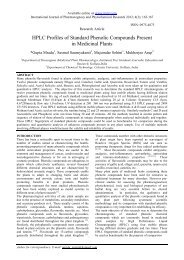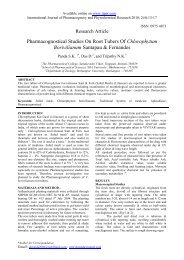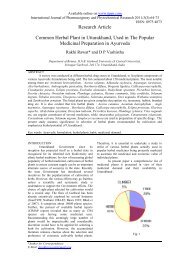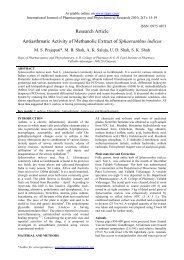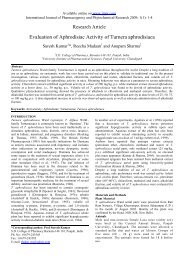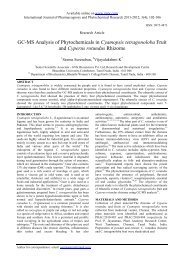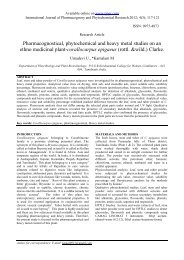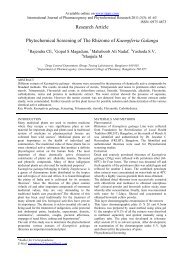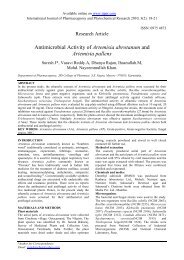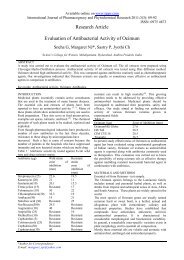Antimicrobial Activity of Stem Bark Extracts of Nyctanthes arbortristis ...
Antimicrobial Activity of Stem Bark Extracts of Nyctanthes arbortristis ...
Antimicrobial Activity of Stem Bark Extracts of Nyctanthes arbortristis ...
You also want an ePaper? Increase the reach of your titles
YUMPU automatically turns print PDFs into web optimized ePapers that Google loves.
Available online on www.ijppr.com<br />
International Journal <strong>of</strong> Pharmacognosy and Phytochemical Research 2009; 1(1): 12-14<br />
Research Article<br />
<strong>Antimicrobial</strong> <strong>Activity</strong> <strong>of</strong> <strong>Stem</strong> <strong>Bark</strong> <strong>Extracts</strong> <strong>of</strong><br />
<strong>Nyctanthes</strong> <strong>arbortristis</strong> linn. (Oleaceae)<br />
Vats Manisha*, Sharma Neha and Sardana Satish<br />
Department <strong>of</strong> Pharmacognosy, Hindu College <strong>of</strong> Pharmacy, Sonipat-131001, Haryana<br />
Abstract<br />
<strong>Nyctanthes</strong> <strong>arbortristis</strong> Linn. belonging to family Oleaceae is a well known medicinal plant.The stem bark extracts <strong>of</strong> the plant were<br />
tested for their in vitro antimicrobial activity by cup plate method. The test organisms were Staphylococcus aureus, Micrococcus<br />
luteus, Bacillus subtilis, Escherichia coli, Pseudomonas aeruginosa, Candida albicans and Aspergillus niger. The zone <strong>of</strong> inhibition<br />
and Minimum Inhibitory Concentration (MIC) <strong>of</strong> the extracts were determined and compared with the standard drugs cipr<strong>of</strong>loxacin<br />
and fluconazole. The chlor<strong>of</strong>orm extract was found to have both antibacterial and antifungal activity whereas the petroleum ether and<br />
ethanol extracts possess only antibacterial activity.<br />
Key words: <strong>Nyctanthes</strong> <strong>arbortristis</strong>, Oleaceae, <strong>Antimicrobial</strong>, MIC<br />
Introduction<br />
The frequency <strong>of</strong> life-threatening infections caused by<br />
pathogenic microorganisms has increased worldwide and is<br />
becoming an important cause <strong>of</strong> morbidity and mortality in<br />
immune compromised patients in developing countries and<br />
many infectious microorganisms are resistant to synthetic<br />
drugs; hence an alternative therapy is very much needed 1 .<br />
Since ages, man has been dependent on nature for curing<br />
various body diseases. From ancient civilization various<br />
parts <strong>of</strong> different plants were used to eliminate pain, control<br />
suffering and counteract disease. Most <strong>of</strong> the drugs used in<br />
primitive medicine were obtained from plants and are the<br />
earliest and principal natural source <strong>of</strong> medicines.<br />
The plants used, as drugs are fairly innocuous and relatively<br />
free from toxic effects or were so toxic that lethal effects<br />
were well known. The nature has provided the storehouse <strong>of</strong><br />
remedies to cure all ailments <strong>of</strong> mankind. There is no doubt<br />
that plants are a reservoir <strong>of</strong> potentially useful chemical<br />
compounds which serve as drugs, are provided newer leads<br />
and clues for modern drug design by synthesis<br />
2 .<br />
<strong>Antimicrobial</strong>s <strong>of</strong> plant origin have enormous therapeutic<br />
potential. They are effective in the treatment <strong>of</strong> infectious<br />
diseases while simultaneously mitigating many <strong>of</strong> the side<br />
effects that are <strong>of</strong>ten associated with synthetic<br />
antimicrobials 3 . <strong>Nyctanthes</strong> <strong>arbortristis</strong> Linn. commonly<br />
known as Harsinghar or Night Jasmine is one <strong>of</strong> the well<br />
known medicinal plants. Different parts <strong>of</strong> N. <strong>arbortristis</strong><br />
are known to possess various ailments by rural mainly tribal<br />
people <strong>of</strong> India (Orissa and Bihar) along with its use in<br />
Ayurveda, Sidha<br />
and Unani systems <strong>of</strong> medicines. Juice <strong>of</strong> the leaves is used<br />
as digestives, antidote to reptile venoms, mild bitter tonic,<br />
laxative, diaphoretic and diuretic 4, 5, 6 . Leaves are also used<br />
in the enlargement <strong>of</strong> spleen. Traditionally the powdered<br />
stem bark is given in rheumatic joint pain, in treatment <strong>of</strong><br />
* Corresponding Author: Vats Manisha<br />
Department <strong>of</strong> Pharmacognosy, Hindu College <strong>of</strong><br />
Pharmacy, Sonipat-131001, Haryana<br />
E-mail: ms.vats@yahoo.com<br />
malaria and also used as an expectorant 5 . The claimed<br />
traditional medicinal uses have been proved on scientific<br />
basis using in-vitro and in-vivo experiments. The plant have<br />
been screened for antihistaminic activity, CNS activities<br />
(viz. hypnotic, tranquillizing, local anesthetics), analgesic,<br />
anti-inflamatory, antipyretic, antiulcer, amoebicidal,<br />
anthelmintic, antitrypanosomal to antidepressant, antiviral<br />
and immunomodulatory 7 . Leaves extracts was found to<br />
have antimicrobial activity 8 but no report is available on the<br />
antimicrobial activity on the stem bark part so the present<br />
study is aimed at the screening <strong>of</strong> the antimicrobial activity<br />
in the stem bark extracts <strong>of</strong> the plant N. <strong>arbortristis</strong> Linn.<br />
MATERIAL AND METHODS<br />
Plant collection and identification:<br />
The stem bark <strong>of</strong> N. <strong>arbortristis</strong> Linn. was collected from<br />
Sonipat, India in June, 2008. The bark was shade dried at<br />
room temperature (30-40 °C). The plant was authenticated at<br />
the National Institute <strong>of</strong> Science Communication and<br />
Information Resources (NISCAIR), New Delhi, under<br />
voucher specimen number NISCAIR/RHMD/Consult/-<br />
2008-09/1058/89.<br />
Preparations <strong>of</strong> <strong>Extracts</strong><br />
The plant material was coarsely powdered and extracted<br />
sequentially with petroleum ether (60-80°C), chlor<strong>of</strong>orm<br />
and ethanol (95%) using Soxhlet apparatus. The extracts<br />
were filtered and allowed to evaporate to dryness. Each<br />
extract was transferred into clean and dried airtight vials<br />
until ready for use.<br />
Microorganisms<br />
The test organisms were Staphylococcus aureus (MTCC<br />
737), Micrococcus luteus (MTCC *106), Bacillus subtilis<br />
(MTCC 441), Escherichia coli (MTCC 443), Pseudomonas<br />
aeruginosa (MTCC 1688), Candida albicans (MTCC 3017)<br />
and Aspergillus niger (MTCC 1344).The microorganisms<br />
were availed from M.T.C.C. Institute <strong>of</strong> Microbial<br />
Technology, Sector 39-A, Chandigarh-160036, India. ST<br />
No: 02/ST/Sci & Tech/STC/Chd/2002. Invoice No.
Manisha Vats et al. / <strong>Antimicrobial</strong> activity <strong>of</strong> stem bark extracts<br />
Table .1: <strong>Antimicrobial</strong> activity (zone <strong>of</strong> inhibition) <strong>of</strong> stem bark extracts <strong>of</strong> N. <strong>arbortristis</strong> Linn.<br />
<strong>Extracts</strong>/ Standards PE CH ETH Cipro Fluco<br />
Conc.(mg/ml) 10 20 40 50 10 20 40 50 10 20 40 50 5 5<br />
Microorganisms<br />
Zone <strong>of</strong> inhibition (mm)<br />
S. aureus 4 5 8 9 7 9 13 15 1 2 4 5 26 NA<br />
B. subtilis 4 6 7 8 5 6 8 10 - 2 3 5 32 NA<br />
M. luteus 3 5 5 6 6 8 11 16 2 3 6 7 14 NA<br />
P. aeruginosa 4 5 8 7 9 11 14 19 6 8 11 12 25 NA<br />
E. coli 3 4 6 6 8 9 11 13 4 5 6 7 22 NA<br />
C. albicans - - - - 3 6 8 11 - - - - NA 13<br />
A. niger - - - - 4 6 8 10 - - - - NA 14<br />
PE = Petroreum ether extract, CH = Chlor<strong>of</strong>orm extract, ETH = Ethanol extract, Cipro = cipr<strong>of</strong>loxacin, Fluco =<br />
fluconazole, S. aureus = Staphylococcus aureus, B. subtilis = Bacillus subtilis, M. luteus = Micrococcus luteus, P.<br />
aeruginosa= Pseudomonas aeruginosa, E. coli = Escherichia coli, C. albicans = Candida albicans, A.niger = Aspergillus<br />
niger, NA = Not Applicable<br />
MTCC/08/10/5396. The organisms were subcultured onto<br />
nutrient agar in order to determine their viability. The<br />
identity <strong>of</strong> each test organism was confirmed using standard<br />
cultural, morphological and biochemical techniques 9 . Stock<br />
cultures were maintained on nutrient agar slants at 4 o C and<br />
then subcultures in nutrient broth at 37 o C prior to each<br />
antimicrobial test<br />
Zone <strong>of</strong> inhibition (mm)<br />
Zone <strong>of</strong> inhibition <strong>of</strong> stem bark extracts <strong>of</strong> N.<br />
<strong>arbortristis</strong> (50mg)<br />
35<br />
30<br />
25<br />
20<br />
15<br />
10<br />
5<br />
0<br />
S. aureus<br />
B. subtilis<br />
M. luteus<br />
P. aeruginosa<br />
E. coli<br />
C. albicans<br />
Microorganisms<br />
A. niger<br />
PE<br />
CH<br />
ETH<br />
Cipro<br />
Fluco<br />
Graph 1: <strong>Antimicrobial</strong> activity (zone <strong>of</strong> inhibition) <strong>of</strong><br />
stem bark extracts <strong>of</strong> N. <strong>arbortristis</strong> Linn. at a<br />
concentration 50mg/ml<br />
glucose agar (Himedia) was used for the activation <strong>of</strong> the<br />
fungi. Nutrient broth was used for MIC determination.<br />
II. Chemicals for antimicrobial assay Cipr<strong>of</strong>loxacin and<br />
Fluconazole (Central Drug House (P). LTD., New Delhi<br />
110002., India) were used as positive reference standards<br />
(RA) for all bacterial and fungi strains respectively. The<br />
dimethylsulfoxide (DMSO) (Qualigenis) was used as<br />
solvent for the tested samples.<br />
III. Assay method<br />
All the experimentation was done in aseptic area under<br />
laminar air-flow cabinet. The agar diffusion method 10 was<br />
adopted for the study. Broth cultures <strong>of</strong> the test isolates (0.1<br />
ml) containing 1.0 X 10 5 CFU/ml <strong>of</strong> organism was<br />
introduced into a sterile petri dish and 15 ml <strong>of</strong> molten<br />
nutrient agar were added. The content was thoroughly mixed<br />
and then allowed to solidify. The extracts were dissolved in<br />
DMSO and used in concentrations 10, 20, 40 and 50 mg/ml.<br />
Cipr<strong>of</strong>loxacin (5µg/ml) was used as standard for<br />
antibacterial activity and Fluconazole (5µg/ml) was used for<br />
antifungal activity. Holes were bored in the plates, using a<br />
standard sterile cork borer <strong>of</strong> 8 mm diameters and equal<br />
volumes <strong>of</strong> the plant extracts (1000 μl) were transferred into<br />
the wells with the aid <strong>of</strong> micropipette. The experiments were<br />
carried out in triplicate. The plates were kept for 1hr for prediffusion<br />
and incubated at 37°C/24hr (plates containing<br />
bacterial cultures), 25°C/3days (plates containing Candida<br />
albicans culture) and 25°C/7days (for plates containing<br />
Aspergillus niger culture). At the end <strong>of</strong> incubation, zone <strong>of</strong><br />
inhibition was measured in all the plates.<br />
Evaluation <strong>of</strong> antimicrobial activity<br />
I. Culture media Nutrient agar (NA) (Himedia) containing<br />
bromocresol purple was used for the activation <strong>of</strong> Bacillus<br />
IV. Minimum inhibitory concentration (MIC)<br />
It was determined by tube dilution method (turbimetric<br />
method) 11, 12 . 1 ml <strong>of</strong> the sterilized media was poured in the<br />
Table.2: Minimum inhibitory concentration <strong>of</strong> stem bark extracts <strong>of</strong> N. <strong>arbortristis</strong> Linn.<br />
Microorganism<br />
PE<br />
(µg/mL)<br />
CH<br />
(µg/mL)<br />
ETH<br />
(µg/mL)<br />
Cipro<br />
(µg/mL)<br />
Fluco<br />
(µg/mL)<br />
S. aureus 12.5 6.25 12.5 0.625 -<br />
B. subtilis 12.5 6.25 12.5 0.625 -<br />
M. luteus 6.25 6.25 6.25 0.625 -<br />
E. coli 6.25 3.12 6.25 0.312 -<br />
P. aeruginosa 3.12 3.12 3.12 0.312 -<br />
A. niger 12.5 12.5 12.5 - 0.625<br />
C. albicans 12.5 6.26 12.5 - 1.25<br />
species, while NA was used for other bacteria. Sabouraud sterile test tubes. The stock solutions <strong>of</strong> the extracts having<br />
IJPPR September –November, 2009, Vol 1, Issue 1(12-14) 13
Manisha Vats et al. / <strong>Antimicrobial</strong> activity <strong>of</strong> stem bark extracts<br />
concentration <strong>of</strong> 50 µg/ml were used. The extracts were<br />
serially diluted to give a concentration <strong>of</strong> 25, 12.5, 6.25,<br />
3.12 and 1.56 µg/ml. In all the test tubes 0.1 ml <strong>of</strong><br />
suspension <strong>of</strong> bacteria in saline was added and incubated at<br />
37°C/24hr (Plates containing bacterial cultures), 25°C/3days<br />
(for plates containing Candida albicans culture) and for<br />
25°C /7days (for plates containing Aspergillus niger<br />
culture). Post-incubation<br />
the plates were observed for turbidity.<br />
RESULTS AND DISCUSSION<br />
Table 1 shows the results <strong>of</strong> antimicrobial activity against<br />
the tested microorganisms. All extracts showed varying<br />
degrees <strong>of</strong> inhibition against all the bacterial stains but only<br />
chlor<strong>of</strong>orm extract possess antifungal activity against<br />
Candida albicans and Aspergillus niger. Graph 1 shows the<br />
comparison <strong>of</strong> the different extracts at a concentration <strong>of</strong><br />
50mg/ml with the standard drugs. Chlor<strong>of</strong>orm extract<br />
showed higher zone <strong>of</strong> inhibition as compared with the<br />
petroleum ether and ethanol extracts and it is found to be<br />
more active against Pseudomonas aeruginosa as compared<br />
in comparison with the other tested bacteria. The Minimum<br />
Inhibitory Concentration (MIC) values <strong>of</strong> the extracts<br />
against tested microorganisms were shown in Table 2. It<br />
showed that MIC for Pseudomonas aeruginosa is found to<br />
be less followed by Micrococcus luteus and Escherichia coli<br />
as compared with other tested microorganisms. Overall<br />
chlor<strong>of</strong>orm extract <strong>of</strong> the stem bark <strong>of</strong> N. <strong>arbortristis</strong> Linn.<br />
exhibited significant activity .<br />
References<br />
1. Al-Bari MAA, Sayeed MA, Rahman MS. Characterization and<br />
antimicrobial activities <strong>of</strong> extracts in a phenolic acid derivative<br />
produced by Streptomyces bangladeshiensis, a novel species<br />
collected in Bangladesh. Res. J. Med. and Med. Sci., 2006, 1:<br />
77-81.<br />
2. Kiew R, Baas P. <strong>Nyctanthes</strong> is a member <strong>of</strong> Oleaceae. Proc.<br />
Indian Acad. Sc. (Plant Sc.). 1984, 93(3): 349-358.<br />
3. Iwu MW, Duncan AR, Okunji CO. New antimicrobials <strong>of</strong> plant<br />
origin. In: J. Janick (ed.), Perspectives on new crops and new<br />
uses. ASHS Press, Alexandria, VA. 1999, 457-462.<br />
4. Nadkarni AK. Indian Materia Medica, Vol.I, 3rd ed. (Popular<br />
Prakashan Pvt. Ltd.,) 1982, 857-858.<br />
5. Kirtikar KR, Basu BD. Indian Medicinal Plants, Vol.VII, (Sri<br />
Satguru Publications, New Delhi,) 2000, 2110-2113.<br />
6. Wealth <strong>of</strong> India, A Dictionary <strong>of</strong> Indian Raw Materials and<br />
Industrial Products, Vol.VII, (National Institute <strong>of</strong> Science<br />
Communication, CSIR, New Delhi), 1997, 69-70.<br />
7. Sasmal D, Das Sanjita, Basu S P. Phytoconstituents and<br />
therapeutic potential <strong>of</strong> <strong>Nyctanthes</strong> <strong>arbortristis</strong> Linn.,<br />
Pharmacognosy Reviews, 2007; 1 (2): 344-349<br />
8. Khandelwal KR, Kadam SS, Singhama. Antibacterial acivity <strong>of</strong><br />
the leaves <strong>of</strong> <strong>Nyctanthes</strong> <strong>arbortristis</strong> Linn. Indian J. Nat. Prod.,<br />
1999; 15: 18-20.<br />
9. Cowan M, Steel L. Preparation <strong>of</strong> the test organisms. Niger. J.<br />
Microbiol. 1965; 22: 56-60.<br />
10. Osadebe PO, Ukwueze SE. A comparative study <strong>of</strong> the<br />
phytochemical and antimicrobial properties <strong>of</strong> the Eastern<br />
Nigerian species <strong>of</strong> African Mistle foe (Loranthus nucranthus)<br />
sourced from different host trees. J. Biol. Res. Biotechnol.,<br />
2004; 2(1): 18-23.<br />
11. Iwaki K, S Koya-Miyata, Kohno K, Ushio S, Fukuda S.<br />
<strong>Antimicrobial</strong> activity <strong>of</strong> Polygonum tinctorium Lour: extract<br />
against oral pathogenic bacteria. Nat. Med., 2006; 53: 72-79.<br />
12. Khan A, Rahman M, Islam S. Antibacterial, antifungal and<br />
cytotoxic activities <strong>of</strong> tuberous roots <strong>of</strong> Amorphophallus<br />
campanulatus. Turk. J. Biol., 2007; 31: 167-172.<br />
IJPPR September –November, 2009, Vol 1, Issue 1(12-14) 14



